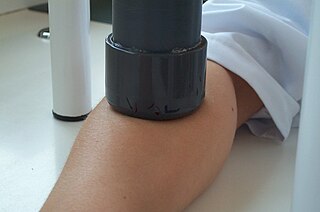Related Research Articles
Anetoderma is a benign but uncommon disorder that causes localized areas of flaccid or herniated sac-like skin due to a focal reduction of dermal elastic tissue. Anetoderma is subclassified as primary anetoderma, secondary anetoderma, iatrogenic anetoderma of prematurity, congenital anetoderma, familial anetoderma, and drug-induced anetoderma.
Acquired progressive lymphangioma, also known as benign lymphangioendothelioma is a group of lymphangiomas that occur anywhere in young individuals, grow slowly, and present as bruise-like lesions or erythematous macules. Acquired progressive lymphangioma may develop following radiation therapy, surgery, trauma, inflammation, and tick bites. The treatment of choice is complete surgical excision.

Onychomadesis is a periodic idiopathic shedding of the nails beginning at the proximal end, possibly caused by the temporary arrest of the function of the nail matrix. One cause in children is hand, foot, and mouth disease. This generally resolves without complication.

Onychauxis presents with thickened nails without deformity, and this simple thickening may be the result of trauma, acromegaly, Darier's disease, psoriasis, or pityriasis rubra pilaris, or, in some cases, hereditary.
Spotted lunulae is a distinctive change that occurs with alopecia areata.
Red lunulae is characterized by a dusky erythema confined to the lunulae, as has been reported in association with alopecia areata. It is most commonly seen on the thumbnail.
Melanonychia is a black or brown pigmentation of a nail, and may be present as a normal finding on many digits in Afro-Caribbeans, as a result of trauma, systemic disease, or medications, or as a postinflammatory event from such localized events as lichen planus or fixed drug eruption.
Longitudinal erythronychia presents with longitudinal red bands in the nail plate that commence in the matrix and extend to the point of separation of the nail plate and nailbed, and may occur on multiple nails with inflammatory conditions such as lichen planus or Darier's disease. Longitudinal erythronychia is usually asymptomatic but can sometimes be associated with pain.
Pincer nails are a toenail disorder in which the lateral edges of the nail slowly approach one another, compressing the nailbed and underlying dermis. It occurs less often in the fingernails than toenails, and there usually are no symptoms.
Pterygium inversum unguis or ventral pterygium is characterized by the adherence of the distal portion of the nailbed to the ventral surface of the nail plate. The condition may be present at birth or acquired, and may cause pain with manipulation of small objects, typing, and close manicuring of the nail. secondary due to connective tissue disorders. Pterygium inversum unguis is often asymptomatic.
Chevron nail, also known as a herringbone nail, is a rare transient fingernail ridge pattern seen in children, a ridge arising from the proximal nailfold and converging in a V-shaped pattern towards the midpoint distally. The nail growth pattern has no known association with medical problems and tends to resolve by early adulthood.

Pressure urticaria or delayed pressure urticaria is a physical urticaria caused by pressure applied to the skin, and is characterized by the development of swelling and pain that usually occurs 3 to 12 hours after local pressure has been applied.
Malalignment of the nail plate, also known as congenital malalignment of the great toenails or congenital malalignment syndrome, is a congenital malalignment of the nail of the great toe, and is often misdiagnosed although it is a common condition. It most commonly affects the hallucices. The nail might be discolored and develop infections. If the misaligned nail becomes embedded in the lateral nail fold it can cause pain, inflammation and erythema.
Acral persistent papular mucinosis (APPM) is a rare form of lichen myxedematosus. It is characterized by small papules on the backs of the hands, wrists, and extensor aspects of the distal forearms, with no further clinical or laboratory indications. Lesions tend to persist and may grow in number gradually. Because there are no symptoms, treatment is rarely required.
Self-healing juvenile cutaneous mucinosis is a skin condition caused by fibroblasts producing abnormally large amounts of mucopolysaccharides, and is characterized by the sudden onset of skin lesions and polyarthritis.
Onychomatricoma is a cutaneous condition characterized by a distinctive tumor of the nail matrix.

Generalized granuloma annulare is a skin condition of unknown cause, tending to affect women in the fifth and sixth decades, presenting as a diffuse but symmetrical, papular or annular eruption of more than ten skin lesions, and often hundreds.

Airbag dermatitis is skin irritation secondary to the deployment of airbags. The diagnosis of "air bag dermatitis" is relatively recent; the first case was reported in 1994.
Rheumatoid neutrophilic dermatitis, also known as rheumatoid neutrophilic dermatosis, is a cutaneous condition associated with rheumatoid arthritis.
Short anagen syndrome is a condition where hair does not grow beyond a short length, due to an unusually short duration of active hair growth. Most cases are associated with fine blond hair.
References
- ↑ James, William Daniel; Berger, Timothy G.; Elston, Dirk M. (2006). Andrews' Diseases of the Skin: Clinical Dermatology (10 ed.). Saunders Elsevier. p. 784. ISBN 978-0-8089-2351-0 . Retrieved 11 May 2024.